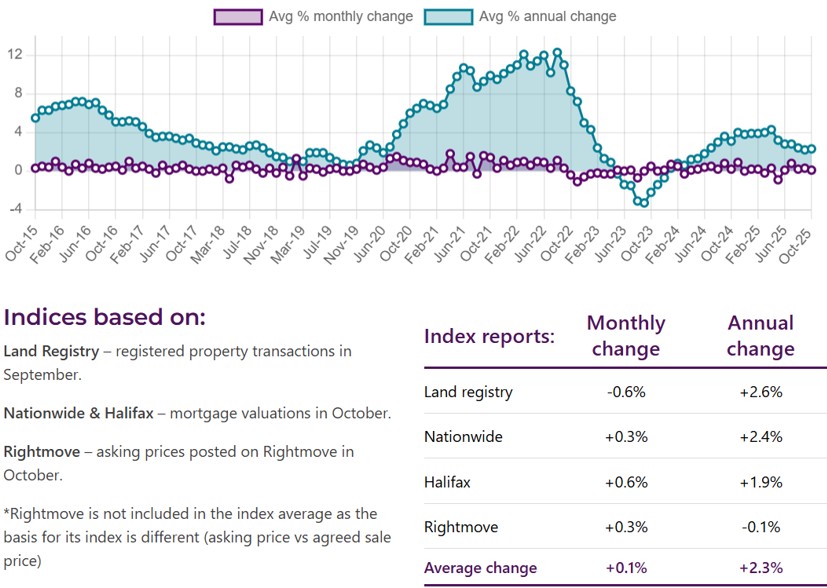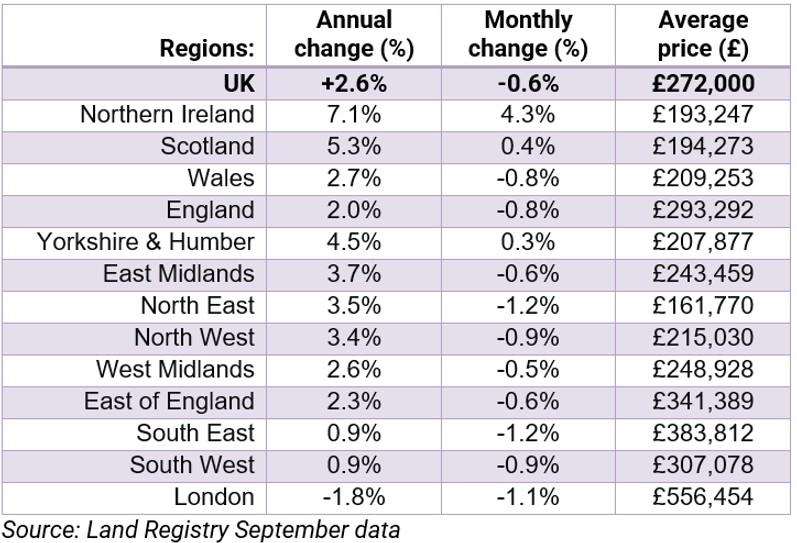UK house price latest 2025: what's happening to property values near you

No signs of the usual Autumn bounce as ongoing affordability issues and fears over a Budget tax raid subdue the market. Read on to see what's happening to house prices in your area.
Feeling a bit lost with so many house price reports out there?
The HomeOwners Alliance House Price Watch looks at all the information from the various property indices to give you one easy-to-digest round-up of everything you need to know.
So, let's look at how prices have changed over the past month and year.
What’s going on with house prices?
When you average out the latest figures reported by all the major indices, prices edged 0.1% upward in the last month and 2.3% over the last 12 months.
It means the typical home now costs £272,000, which is around £6,000 higher than a year ago.
Another interesting trend is the increasing North-South divide, with more affordable homes driving bigger price gains in the North (more on that later).

What will happen to house prices for the rest of 2025?
House prices normally see an uptick around October, but we've seen no signs of the traditional 'Autumn bounce' this year.
One factor is the potential impact of tax hikes being announced in next week's Budget, which property portal Rightmove suggests could be putting buyers off.
“Despite the overall resilience of the 2025 housing market, we’ve not got enough pent-up momentum or recent positive sentiment to spur the usual Autumn bounce in property prices," it said.
“We’re experiencing a decade-high level of property choice for buyers, which means that sellers who are serious about selling have had to acknowledge their limited pricing power and moderate their price expectations.
“In addition, speculation that the Budget may increase the cost of buying or owning a property at the higher end of the market has given some movers, particularly in the South of England, a reason to wait and see what’s announced in the Budget.”
Another big factor is that many houses are simply unaffordable for buyers.
However, the latest analysis by Halifax suggests the issue is slowly improving and prices should see a slow rise for the remainder of the year.
“There is no doubt that affordability remains a challenge for many," it said.
“Average fixed-rate mortgage rates are currently around 4% and likely to ease down further, but with property prices at record levels, moving home can feel like a stretch.
"Many buyers opt for smaller deposits and longer terms to help make the numbers work.
“With house prices rising more slowly than incomes for almost three years now, we expect the trend of gradually improving affordability to continue.”
7 reasons why no one is buying your house
What's happening to house prices near me?
Land Registry has the most comprehensive data regarding housing stock, and it provides a handy regional breakdown of house prices across the UK.
This data takes slightly longer to compile, so it isn't quite as up-to-date as the other property indices – its latest prices cover up to September 2025 – but it nonetheless provides an interesting insight into how areas are faring relative to each other.
In the 12 months up to that point, prices increased in every region except London.
The housing market in Northern Ireland has proved the most buoyant over that period, with prices jumping 7.1% annually, while Scotland (5.5%) has also seen sizeable gains.
In England, Yorkshire and the Humber (4.5%), the East Midlands (3.7%), the North East (3.5%) and North West (3.4%) were the strongest-performing regions..
At the other end of the scale, London saw prices fall by 1.8% during the same period.
Relatively weak growth in the South East (0.9%) and South West (0.9%) regions provides further evidence that the market is far more subdued in the South compared to the North.
See the table below for a full breakdown of prices by region.

What the indices say
Homeowners Alliance
“Uncertainty surrounding potential November budget measures has muted the usual Autumn bounce, with buyer demand, new listings, and agreed sales all down this month.
“This appears to be prompting a ‘wait-and-see’ approach among new buyers, while committed buyers are increasingly price-sensitive, keeping a lid on house-price inflation and slowing the pace of sales; particularly in London, the South East and South West of England.”
Rightmove
“Despite the overall resilience of the 2025 housing market, we’ve not got enough pent-up momentum or recent positive sentiment to spur the usual Autumn bounce in property prices.
“We’re experiencing a decade-high level of property choice for buyers, which means that sellers who are serious about selling have had to acknowledge their limited pricing power and moderate their price expectations.
“In addition, speculation that the Budget may increase the cost of buying or owning a property at the higher end of the market, has given some movers, particularly in the south of England, a reason to wait and see what’s announced in the Budget.”
Nationwide
“The housing market has remained broadly stable in recent months, with house prices rising at a modest pace and the number of mortgages approved for house purchase maintained at similar levels to those prevailing before the pandemic struck.
“Against a backdrop of subdued consumer confidence and signs of weakening in the labour market, this performance indicates resilience, especially since mortgage rates are more than double the level they were before Covid struck and house prices are close to all-time highs.”
Halifax
"House prices rose by +0.6% in October vs a fall of -0.3% in September.
“While there has been some volatility, the market has proven resilient over recent months.
“There is no doubt that affordability remains a challenge for many.
“Average fixed mortgage rates are currently around 4% and likely to ease down further, but with property prices at record levels, moving home can feel like a stretch. Many buyers opt for smaller deposits and longer terms to help make the numbers work.
“With house prices rising more slowly than incomes for almost three years now, we expect the trend of gradually improving affordability to continue.”
Zoopla
“Budget uncertainty is prompting buyers to ‘wait and see’, leading to the first annual decline in sales agreed in two years.
“Compared with a year ago¹, buyer demand is down 8% and sales agreed are down 3%, as the usual pre-Christmas slowdown begins 6 to 8 weeks earlier than normal.
“More homes for sale (+7%) is giving serious buyers greater choice. A rise in homes for sale and softer demand have pushed up the average time to sell to 37 days, around 10% longer than a year ago.
“House price inflation has slowed over 2025. Realistic pricing is key to securing home sales.
“The wider economic backdrop is not strong enough to drive further growth in sales volumes in the near term.
“We expect the number of sales agreed to stabilise at current levels, with continued demand for well-priced homes.”
RICS
"The October 2025 RICS UK Residential Survey results indicate that the sales market remains subdued, with measures of buyer demand and agreed sales still in negative territory.
“Anecdotally, comments from contributors suggest that uncertainty surrounding potential tax-raising measures in the upcoming Budget is contributing to the current cautious mood.”
Comments
Be the first to comment
Do you want to comment on this article? You need to be signed in for this feature